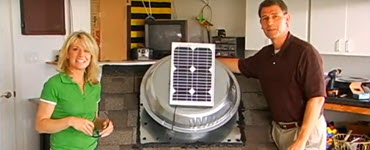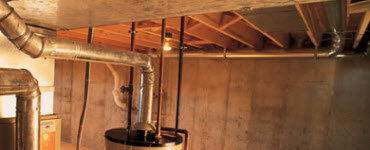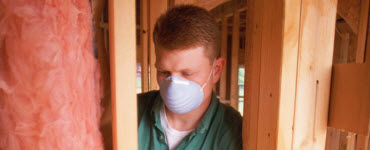Insulation options
Insulation types
Insulating an older home
Insulate with recycled newspaper
Types of insulation
- Fiberglass is the most common type of insulation. It's made from molten glass spun into microfibers. It's usually pink or yellow and comes in the form of batts or rolled blankets.
- Rock wool is literally made from rock - it's manufactured similar to fiberglass, but with molten rock instead of glass. The gray or brown fibers come in batts or blankets, or as shredded loose-fill.
- Cellulose is made from shredded recycled paper, such as newsprint or cardboard. It's treated with chemicals to make it fire- and insect-resistant, and is applied as loose-fill or wet-sprayed through a machine.
- Synthetic insulation, usually polystyrene or polyurethane foam, is commonly used in rigid boards for insulating basements, cathedral ceilings or sidewalls.
Spray foam insulation
Spray-on insulation is made of polyurethane foam – the same kind of insulation appliance manufacturers have used in refrigerators and water heaters for years. The liquid polyurethane is pumped through pressurized spray nozzles – as it lands on the surface of your attic or side walls, it expands to form a continuous insulating barrier.
Unlike traditional insulating materials like fiberglass or cellulose, spray foam insulation can seal and fill all the tiny cracks and seams you might not even see. The seamless material virtually eliminates energy-wasting air filtration.
In addition, polyurethane has the highest R-value for any given thickness compared to other insulation products. Because it provides a higher R-value per inch, homeowners using foam insulation can use 2x4 construction on exterior walls instead of the 2x6 studs required with traditional insulation. Foam insulation also helps control moisture condensation, it won’t shrink or settle, and it’s fire- and insect-resistant.
Spray foam insulation is not a do-it-yourself project – you’ll need to hire a contractor certified in applying this new technology. It’s also a messy process, so it’s better for new construction rather than existing homes. And using foam insulation in sidewalls may cause difficulties or delays if electrical and plumbing contractors aren’t familiar working around it.
The initial cost of using spray foam insulation runs about three times more than traditional materials. But keep in mind that the increase in R-value and air sealing will lower your utility bills by 30 percent - paying back the cost difference in energy savings in less than five years.
More from this category
Weatherizing tips & tricks
Use this checklist to make sure you don't overlook hidden energy wasters in and around your home.
Vapor barriers & ventilation
An energy-tight home requires adequate ventilation and vapor control to maintain healthy air.
Weatherizing materials
A typical home will need about $50 in weatherizing materials - and the cost can be paid back in energy savings in just a few weeks.
Solar attic fan
Spray foam insulation
Spray foam insulation does a great job of sealing up cracks and crevices, if it's installed properly. Learn more about open-cell spray foam options.
Basements and crawlspaces
Insulating your new house's basement up to R-10 can help reduce energy costs by up to 12 percent.








